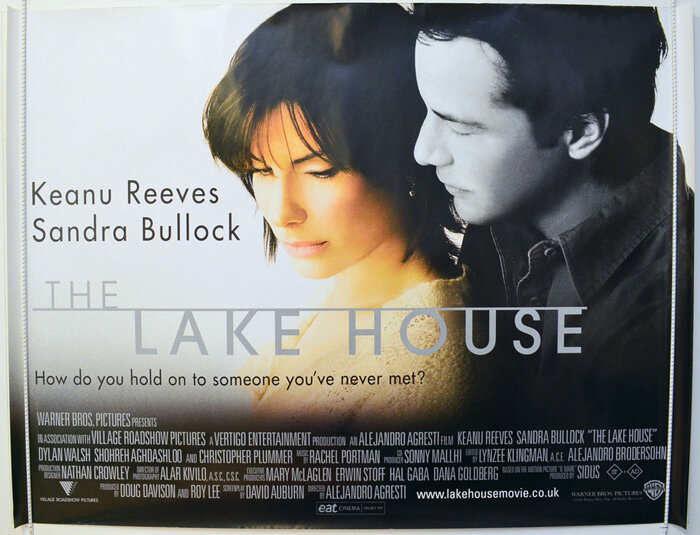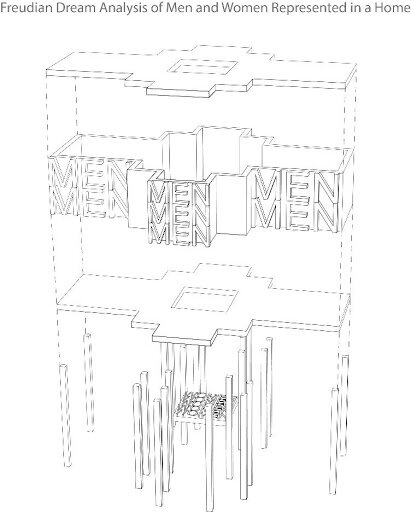
(Image: pastposters.com)
Time-Transcending Architecture in The Lake House
By Tessa Cleary
“Home is where the heart is” is an expression used to portray the feeling that someone acquires in a building but is realistically used to describe the way they interact with the space around them. The house that was constructed in Alejandro Agresti’s The Lake House, is a prime example of how a building can be considered successful architecture but lacks the interconnectivity that a home needs with the dweller. Years ago, people would stay in their home almost the entirety of their life usually due to things like lack financial stability, inability to move or neighboring family ties. Now it seems as though it is very common to move from place to place throughout the span of one’s life. When someone moves around frequently, it makes the house they dwell in less special because of the lack of time spent in that place to create memories and connect with the space and the people who live in it.
In the film The Lake House, an architect named Alex is seen in the house many different times to exaggerate the fact that he is a designer and that the house he lives in is out of the ordinary. The house sits on stilts by a lake and takes on the appearance of being bigger than it is because it is surrounded by windows. Alex describes this affect as, “a glass box with a view of everything that’s around it, but you can’t touch it. There is no interconnection between you and what you’re looking at. (See figure 1)” When thinking about cinema, a film is only as good as the director and the scenes included. A movie that is considered successful usually targets a certain audience, but that audience can never fully interact with the peoples or scenes in the film. In a sense there is a correlation between the camera acting as the glass box from The Lake House, and the people being filmed by the movie camera being the scene around the house that you can look at but have no inter-connectivity with. The house essentially in itself becomes a movie that the audience is drawn to but can never fully connect with.

Figure 1
This phenomenon between the camera and the people behind it have a direct correlation with Alex and his love interest in the movie, Kate. They live in two different time periods where Kate is in the year 2006 and Alex is in 2004. They write to each other through letters that travel back and forth through time in the mailbox of the lake house in which they both reside, just two years apart. Because of the two-year time difference, Alex physically meets Kate multiple times before she even figures out that he exists through the letters. If he tells her who he is before she receives the letters two years later, he would just seem insane and could ruin their entire relationship. Although he wishes he could tell her who he is, the only thing that keeps the two of their lives together is the lake house in which they both reside.
Although Kate moved out of the lake house before Alex arrived to live in it, she continues to be drawn to the property due to her interest in Alex and hearing about how he interacts with the lake house. Alex on the other hand moved into the lake house prior to Kate because his father built the house and he felt obligated to keep it in the family. Little did he know, after he moved, he would discover just how much Kate enjoyed her time spent in the house. The two both resided in the house just for a short period of time which could’ve made the house disposable in their memory. The only thing that kept them both intertwined with the memory of the lake house was each other.
The house being a glass box reinforces the idea of its lack of inter-connectivity. There is a maple tree growing in the center of the house with a mechanism that can open up to the sky. Alex describes this phenomenon of the maple tree being an interior element but also having the ability to open as “containment and control.” This idea of containment and control relates to another analogy where the house is compared to a cage. An animal’s cage is the embodiment of containment because of the idea of the animal being trapped. In a way, Alex felt as though he was trapped in the house and unable to find any sort of happiness or belonging in it. He then goes on to explain that the house is about ownership, not connection. This brings us back to the idea that there is no inter-connectivity with the house because he describes it as beautiful but incomplete. All this uncertainty and disconnect is then fulfilled at the end of the movie when he and Kate live together, and they make the house a home.
Sigmund Freud describes the symbolism of a house like a man and woman. The man being the walls that make up the structure of the house, and the deck being the woman who clings onto the man (See figure 2). This juxtaposition can directly be related to the house in The Lake House because there are massive stilts holding up the house with a deck clinging to the base of it right above the water. In The Lake House, the walls and stilts are the main structural aspects of the house, but the walls are made completely of windows which can be related back to Alex’s fragility in his relationship with Kate. The house is accompanied by small decks surrounding it, but the lower deck doesn’t get added on until after Alex meets Kate. This symbolizes the completion of the house because Kate, symbolizing the deck of the house, gets put into Alex’s life.

Figure 2
The two characters in this movie both only live in the house for short periods of time but their love for the place is symbolized in their love for each other. The space wouldn’t be the same had it not been for the letters that were exchanged between the two, making the house a home. The key aspect to the house being so special was the shared interaction and memory that the two main characters created. Although the design of the house may be considered successful by some, it is the work of the dwellers that make the house livable.
Citations
“Before Sandra and Keanu - Building The Lake House.” Before Sandra and Keanu - Building The Lake House, January 1, 1970. https://ift.tt/2PMpnp8 and-keanu-building-lake.html.
Chocano, Carina. “'Lake House' Is a Love Story That's All about Location.” Los Angeles Times. Los Angeles Times, June 16, 2006. https://ift.tt/2RTzniG.
“The Freudian Symbolism in Your Dreams.” Psychology Today. Sussex Publishers. Accessed November 5, 2019. https://ift.tt/2PJz9Z1 ooze/201801/the-freudian-symbolism-in-your-dreams.
The Lake House. Warner Bros, 2006.
The Man with the Movie Camera: Fragments from a Camermans Diary. VUFKU, 1929.
Portilla, Daniel. “Films & Architecture: ‘The Lake House.’” ArchDaily, October 16, 2012. https://ift.tt/35fjs2k.
from REVIEW BLOG - Every Movie Has a Lesson https://ift.tt/35g74io







No comments:
Post a Comment